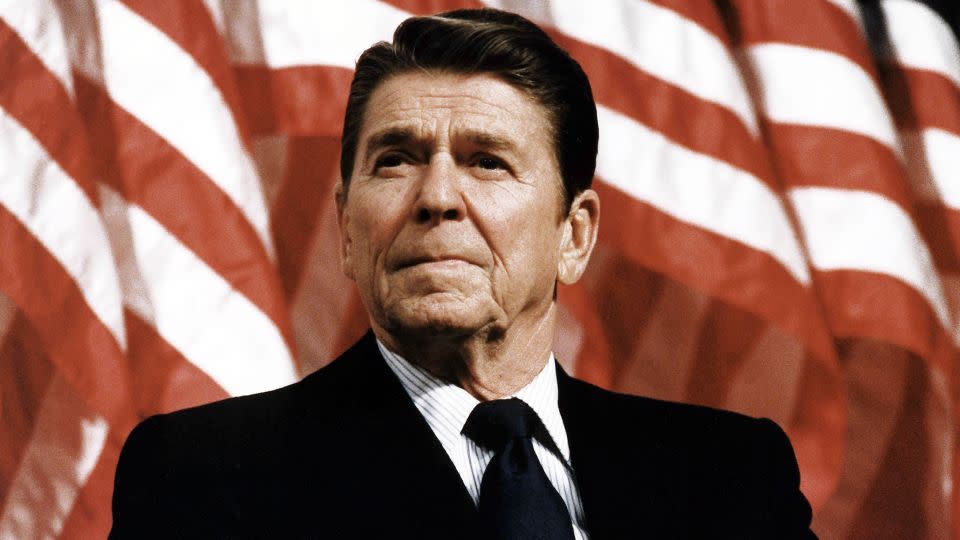How ‘The Day After’ brought Americans together – and helped end the Cold War
- Oops!Something went wrong.Please try again later.
- Oops!Something went wrong.Please try again later.
On November 20, 1983, a record audience estimated at more than 100 million Americans assembled in a very different TV era to watch a “What if?” movie about nuclear annihilation. That made-for-TV film, “The Day After,” not only served as a highwater mark for the genre but almost surely contributed to hastening the end of the Cold War.
Even before the movie aired, the subject matter alarmed the Reagan White House, which feared the depiction of a nuclear strike and its effects on a group of people in Kansas might shake America’s resolve and potentially cause panic.
The dialogue between the administration and ABC executives included reports President Ronald Reagan asked ABC’s chairman, Leonard Goldenson, to “bury the movie” over a game of golf.
“The Day After” was the brainchild of then-ABC Entertainment chief Brandon Stoddard, inspired in part by the 1979 movie “The China Syndrome,” which imagined a possible meltdown at a nuclear plant – and received a real-life boost from an unsettling episode at the Three Mile Island facility weeks after the film opened.
In an interview for the Television Academy’s Archives of American Television, Stoddard, who died in 2014, recalled that advertisers were “terrified to be in the movie,” which carried only 12 minutes of commercials, and went ad-free the last 45 minutes when the bombs fell.
“The Day After” didn’t air in a vacuum. It premiered the same year as the movies “WarGames,” which dealt with a nuclear threat caused by artificial intelligence; and “Testament,” a quietly devastating PBS production that also played in theaters.
Still, the ABC presentation brought the horror directly into living rooms on a mass scale. According to Nielsen research, 46% of all US homes tuned in. The network followed the movie with a special broadcast of a news program hosted by Ted Koppel, “Viewpoint,” addressing the anxieties that the movie reflected – and provoked.
The huge audience for “The Day After” – second only to the “MASH” finale earlier that year among entertainment programs (thus excluding Super Bowls) – reached the country and influenced public opinion in ways that seem almost unimaginable in a streaming age characterized by an abundance of content and the fragmented viewing that goes with it.

David Craig, a professor at the University of Southern California’s Annenberg School, documents the movie’s impact in a new book, “Apocalypse Television: How ‘The Day After’ Helped End the Cold War.”
A veteran producer of TV movies, Craig became interested in the commitment by Stoddard and his team to use television to tell important stories, leveraging their successes with more commercial fare that “afforded them the chance to once in a while put everything on the line for something like this,” he told CNN.
The book also explores the effect “The Day After” had on Reagan and the country at large, with Craig’s reporting suggesting that Reagan – who, given his background in movies, famously saw and described the world through cinematic narratives – changed the tone of his rhetoric within weeks of the broadcast, later finding a receptive counterpart in the Soviet Union’s Mikhail Gorbachev.
“In a way, I believe the movie finally gave Reagan the license to come out as a nuclear abolitionist,” Craig said.
In a foreword to Craig’s book Robert Iger, the current Disney CEO who replaced Stoddard as president of ABC Entertainment, lauded his predecessor for having “harnessed the power of the medium to educate the public and raise awareness, while still delivering ratings and profits to the network.”
The Cold War would end, at least in that form, but so would the dominance of the Big Three networks – and the prevalence of shared viewing experiences – that “The Day After” so vividly illustrated. (The FX series “The Americans,” about Soviet spies operating in the US, dramatized the powerful reaction the movie unleashed in a 2016 episode.)
“The Day After” made its debut not only during the arms race but the peak of broadcast TV, epitomized in the 1970s and ‘80s by programs like “Roots” and “Dallas’” “Who Shot J.R.?” episode, which also amassed huge audiences.
“After 1983,” Iger wrote, “the arrival of cable, streaming services, and the atomizing effect of the Internet meant that television would never be the same.”
For more CNN news and newsletters create an account at CNN.com

